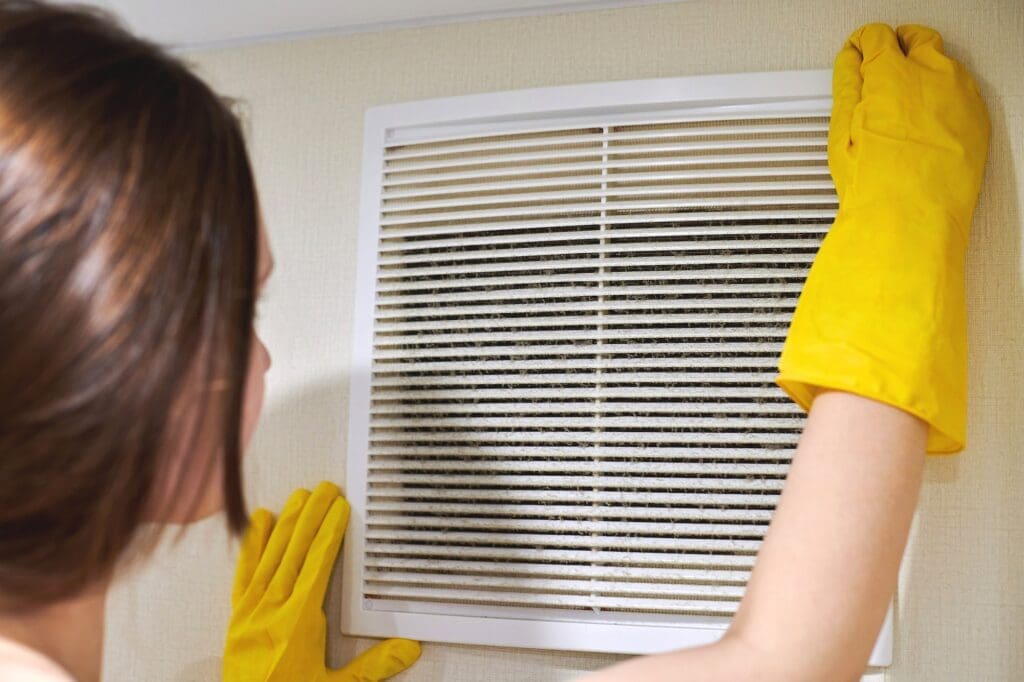Dry As A Bone: Preventing Water Damage In Your Home
I’ll be honest with you; there’s nothing more gut-wrenching to me as a home restoration specialist than stepping into a client’s house and seeing the devastating effects of water damage.
We often take our homes for granted, but if we don’t pay attention, that leaky faucet or unexpected storm can turn your sanctuary into a nightmare in no time.
That’s why I’m here today: to help you keep your home dry as a bone and prevent those catastrophes from ever happening.
You see, it isn’t just about saving yourself the headache and expense of dealing with water damage – though that alone is reason enough!
It’s also about preserving the sanctity of your space so you can continue serving others without worry.
Your home should be a place where family and friends feel welcomed and cared for, not an environment filled with stress-inducing hazards.
So let’s dive right in together and explore some practical steps to ensure your home stays safe from the ravages of water damage.
Inspect Your Plumbing
Did you know that water damage is the second most frequently filed insurance claim in the United States? With an average of 14,000 people experiencing a water damage emergency at home or work each day, it’s no wonder we’re all eager to keep our homes dry as a bone.
As a home restoration specialist, I can’t stress enough how important it is to inspect your plumbing regularly. One way to do this is by reviewing sewer lines and maintaining proper drainage systems.
Now, let me tell you why this matters so much: clogged or damaged sewer lines can lead to nasty backups and even flooding in your home, which not only causes expensive repairs but also poses health risks for you and your family.
By taking the time to maintain drainage systems around your property and keeping an eye on those crucial sewer lines, you’ll be playing a huge role in preventing potential disasters from happening – think about how good that will feel! And remember, serving others starts with protecting our own homes first.
Now that we’ve covered the importance of inspecting plumbing, next up is checking for leaks around appliances – another essential step towards keeping your sanctuary safe and dry.
Check For Leaks Around Appliances
Now that you’ve given your plumbing a thorough once-over, it’s time to turn our attention to another common source of water damage – leaks around appliances. Many household appliances use water in their operation and can be potential culprits when trying to prevent water damage in your home. Let’s focus on performing regular checks for these sneaky drips.
To properly check for appliance leaks, follow this simple three-step process:
- Check hoses: Inspect the hoses connected to your washing machine, dishwasher, refrigerator (if it has a water dispenser or ice maker), and any other water-using appliances. Look for signs of wear and tear or loose connections.
- Inspect seals: Check the door gaskets on your dishwasher and refrigerator/freezer as well as any rubber seals around faucets or hose connections. Make sure they’re clean and free from cracks or tears.
- Monitor usage: Keep an eye out for any unusual spikes in your water bill, which could indicate a hidden leak somewhere in your home.
By taking these steps, not only will you help protect your home from possible water damage caused by leaking appliances but also contribute towards creating a safe environment for others who may occupy the space after you move on to a new place.
As we continue exploring various ways to keep our homes dry as a bone, let us venture into discussing how installing a sump pump plays a pivotal role in preventing basement flooding situations.
Install A Sump Pump
When it comes to installing a sump pump, there are a few types to choose from and it’s important to match the right pump to the job at hand. To ensure proper installation, I’d suggest getting a professional to help you out – they’ll know how to best situate the pump so it can do its job. Lastly, to keep your sump pump running smoothly, it’s important to remember to check it regularly and perform any necessary maintenance and care.
Types Of Sump Pumps
I can’t stress enough the importance of choosing the right type of sump pump for your home, and believe me, it’s a decision you won’t regret!
As a home restoration specialist, I’ve seen firsthand how installing an appropriate sump pump can be a game changer in preventing water damage.
There are mainly two types of sump pumps that homeowners should consider: electric sump pumps and battery-powered ones.
Electric sump pumps offer reliable and consistent performance but may fail during power outages – which often happen during storms when we need them most.
That’s where battery-powered sump pumps come to the rescue! These lifesavers continue working even when there’s no electricity, giving you peace of mind knowing your basement is protected from flooding.
Of course, every situation is unique, so don’t hesitate to consult with professionals or do some research on what suits your needs best – after all, prevention is always better than dealing with costly repairs later on!
Ensuring Proper Installation
Now that you’ve chosen the perfect sump pump for your home, let’s talk about ensuring proper installation.
As a specialist in this field, I can’t emphasize enough how crucial this step is to maintain insulation and keep water out of your basement.
A well-installed sump pump will efficiently do its job without causing any unnecessary stress on your part.
Test fixtures during the installation process to ensure everything is working smoothly before sealing it up.
And remember, if you’re not confident tackling this task yourself, don’t hesitate to call in professionals who are more than happy to help!
After all, we’re here to serve one another and make our homes as safe and comfortable as possible.
Maintenance And Care
Now that we’ve covered the importance of proper installation, let’s talk about the ongoing maintenance and care for your sump pump.
As a home restoration specialist, I know firsthand how essential it is to regularly inspect your system to ensure it remains in optimal working condition.
Remember, you’re not just protecting your basement from water damage; you’re also serving others by maintaining a safe and comfortable environment within your home.
So go ahead, clean those carpets if needed – but don’t forget to check on your sump pump too!
By diligently caring for this vital piece of equipment, you’ll continue enjoying peace of mind knowing you’ve taken every necessary step to safeguard your beloved sanctuary.
Keep Your Gutters Clean
One of the most effective ways to prevent water damage in your home is by keeping your gutters clean. It’s essential for you and me, as homeowners, to regularly clear debris from our gutters and downspouts. This simple task allows rainwater to flow freely away from our homes’ foundations, preventing costly repairs in the long run.
To help us stay on top of this important task, here’s a handy table that breaks down gutter maintenance into manageable steps:
| Step | Task | Notes |
|---|---|---|
| 1 | Inspect gutters for debris | Do this at least twice a year (spring and fall) or more frequently if surrounded by trees |
| 2 | Remove leaves, twigs, and other debris | Use a gutter scoop or garden trowel, and place debris in a bucket or trash bag |
| 3 | Check for signs of wear or damage | Look for cracks, holes, rusted areas, or loose connections; repair damage as needed |
| 4 | Flush gutters with a hose or leaf blower attachment | Ensure water flows smoothly through downspouts; disassemble and unclog any blocked sections |
| 5 | Assess gutter slope & alignment | Gutters should slightly slope toward the downspout for proper drainage; adjust hangers if necessary |
By following these steps consistently, we can keep our gutters functioning optimally and protect our homes from potential water damage. With well-maintained gutters in place, let’s shift our focus upward to another crucial aspect of maintaining a dry home – inspecting your roof regularly.
Inspect Your Roof Regularly
Hey everyone, let’s talk about inspecting your roof regularly to prevent water damage in your home. I’m sure you’ve all seen signs of roof damage, and it’s important to detect roof leaks early on. That way, we can work to prevent any further water damage in the home.
Signs Of Roof Damage
I don’t know about you, but I take great pride in maintaining a safe and comfortable home for my family – and that includes making sure our roof is always in tip-top shape.
As a home restoration specialist, I can tell you firsthand that spotting leaks early on is crucial to preventing extensive water damage to your property.
In fact, identifying damage before it becomes a major issue will not only save you money on repairs but also give you peace of mind knowing your home is well-protected from the elements.
So next time you’re up there cleaning those gutters or hanging holiday lights, be sure to keep an eye out for any signs of wear and tear like loose shingles, cracked flashings, or even areas where water seems to pool after heavy rainfall.
Trust me – catching these issues early on will make all the difference when it comes to safeguarding your beloved abode!
Roof Leaks Detection
Now that we’ve established the importance of keeping a vigilant eye on your roof’s condition, let’s dive into one of the most common issues homeowners face – roof leaks!
As a home restoration specialist, I know that detecting these pesky leaks early can mean the difference between a simple repair and extensive (not to mention expensive) water damage.
By learning how to identify signs of potential leaks, you’ll be well-equipped to keep your home safe from water intrusion and avoid flooding nightmares.
When inspecting your roof, pay close attention to areas around vents, chimneys, and skylights since they’re often more vulnerable to leakage.
Also, check for discolored or damp spots in your attic insulation as this might indicate an ongoing leak.
Remember – it’s our responsibility not only to protect our own homes but also to serve others by sharing valuable knowledge like this with friends and neighbors who may benefit from it too!
So go ahead and spread the word about regular roof inspections; together we can help create safer, drier homes for everyone.
Check For Cracks In The Foundation
Now that you’ve got a good grasp on keeping your roof in check, it’s time to move on to another crucial area: the foundation of your home. Your foundation is quite literally what keeps everything together and standing strong. If there are any weak spots or cracks, water can seep into your house and wreak havoc on both its structure and your belongings.
Not only that, but these issues can also lead to mold growth and create an unhealthy living environment for you and your loved ones. To prevent such catastrophes, make sure to inspect the exterior of your home regularly for any signs of cracking. Repairing cracks as soon as possible will mitigate further damage from water infiltration.
In order to do this effectively, use a high-quality waterproof sealant specifically designed for foundations. This will help keep moisture out and protect against potential structural problems down the line. Additionally, by taking preventive measures like repairing minor flaws before they become major headaches, you’ll be contributing towards maintaining a safe haven not just for yourself but also for others who might seek shelter within your walls during times of need.
With that said, let’s dive into our next tip – investing in a humidifier!
Invest In A Humidifier
Imagine walking into your home, taking a deep breath, and feeling the comforting embrace of perfect humidity. That’s the magic a good humidifier can bring to your living space.
As a home restoration specialist, I’ve seen time and again how investing in a quality humidifier can keep moisture levels balanced while preventing water damage.
Before you jump right in and purchase a humidifier, it’s crucial to choose materials wisely and test moisture levels in various areas of your home. This will ensure that you’re keeping all parts of your house safe from potential threats like mold or structural damage.
Once you’ve found the perfect device for maintaining optimal humidity levels, enjoy its benefits as it silently serves others by providing them with comfortable air quality too!
With this newfound knowledge under our belts, let’s move on to discussing another important aspect: sealing windows and doors properly.
Seal Windows And Doors
Hey everyone, let’s talk about how to seal windows and doors so you can keep your home dry as a bone! First, we need to identify any leaks that might be present. I recommend checking around window frames, door frames, and any other visible cracks in the structure. Next, we’ll have to caulk any gaps that we find. This involves using a sealant to fill in any cracks or holes in the structure. Finally, if necessary, we’ll have to replace any seals that have been worn down. Doing this will ensure that your home is completely protected from water damage.
Identifying Leaks
We’ve all been there – you’re enjoying a cozy night in, and suddenly you notice an unwelcome draft or even worse, a tiny trickle of water coming into your home from around your windows or doors.
As a home restoration specialist, I can’t stress enough the importance of identifying potential leaks early on to keep our homes safe and dry.
Not only does this help maintain pipes by preventing freezing during colder months, but it also helps detect moisture before it causes significant damage like mold growth or wood rot.
Together, we can serve our friends and loved ones better by creating safer living spaces for them as well.
So let’s grab that flashlight and start checking those seals!
Caulking Gaps
Now that we’ve identified those pesky leaks, it’s time to take action and prevent further damage.
One of the most effective ways to seal cracks around windows and doors is by using caulking.
As a home restoration specialist, I can assure you that this simple step can make all the difference in keeping your home dry and comfortable while ultimately helping others live in safer spaces too.
So let’s roll up our sleeves, grab that caulk gun, and start sealing those gaps!
Don’t forget to test seals after application just to be extra sure we’re doing an excellent job protecting our homes from unwanted drafts and water intrusion.
Together, with every gap sealed, we are contributing towards creating warmer and safer environments for everyone involved.
Replacing Seals
Now that we’ve tackled caulking, it’s time to move on to another essential step in sealing windows and doors: replacing seals.
As a home restoration specialist, I know firsthand how crucial it is to ensure your door and window seals are in excellent condition. This not only keeps the elements at bay but also contributes towards creating safer living spaces for others.
So let’s dive into some practical repair tips and waterproofing methods that will have your seals as good as new in no time!
Keep in mind that regularly checking and maintaining these seals can make all the difference between a cozy home and one plagued by drafts or water damage.
By taking care of our own homes, we’re ultimately helping create better environments for everyone around us.
Install A Dehumidifier
Now that you’ve made sure your windows and doors are properly sealed, it’s time to tackle another important aspect of keeping your home dry – the humidity level.
When moisture levels in your home rise, it creates a breeding ground for mold, mildew, and other problems related to water damage.
One effective way to keep humidity under control is by installing a dehumidifier.
A dehumidifier works by pulling excess moisture out of the air, helping to insulate pipes and reduce humidity throughout your home.
This can not only help prevent water damage but also create a more comfortable living environment for you and your family.
By maintaining optimal humidity levels, you’ll be doing your part to serve others as well; after all, providing a safe and healthy home for loved ones is one of life’s most significant responsibilities.
So go ahead and invest in a quality dehumidifier – trust us, it’s worth every penny!
Next on our list: let’s take a closer look at how monitoring basement and crawl spaces can further protect your home from water damage.
Monitor Basement And Crawl Spaces
Have you ever heard the theory that a damp basement or crawl space is just a normal part of homeownership? Well, I’m here to tell you that it’s not true! As a home restoration and remediation specialist, I believe in taking proactive steps to prevent water damage in your home.
One crucial area to focus on is monitoring humidity levels and regularly inspecting drains in basements and crawl spaces. By staying vigilant about these areas, we can help ensure that our homes are as dry as possible – which benefits both us and those around us who rely on our support.
To monitor humidity effectively, consider investing in a hygrometer – this handy tool measures moisture levels so you can keep an eye on potential problem spots. When it comes to inspecting drains, be sure to clear any debris from them regularly (especially after heavy rain) and check for signs of wear or damage that could lead to leaks.
Remember: by keeping basements and crawl spaces clean, well-maintained, and properly ventilated, we’re doing our part in serving others through maintaining healthy living environments for ourselves and our loved ones.
Frequently Asked Questions
How Often Should I Change Or Clean My Hvac Filters To Prevent Water Damage?
How often should you change or clean your HVAC filters to prevent water damage, you ask? Well, my friend, regular maintenance is key here!
As a home restoration/remediation specialist, I can’t stress enough the importance of keeping up with those pesky filters. Ideally, you should be checking and cleaning them every month, especially during heavy usage seasons like summer and winter.
If they’re looking particularly dirty or clogged, go ahead and replace them – it’s better to be safe than sorry when it comes to preventing water damage in your home.
And while we’re on the subject of prevention, don’t forget about weatherproofing your home too! Sealing gaps around windows and doors not only helps keep out drafts but also keeps moisture at bay.
So let’s work together to serve our homes (and others) by maintaining a dry environment that’ll keep us all healthy and happy!
Are There Any Specific Plants Or Landscaping Techniques That Can Help Prevent Water Damage Around My Home’s Foundation?
Oh, the joys of home ownership! Just when you think you’ve mastered gutter maintenance and grading slopes to fend off water damage, Mother Nature plays her trump card: plants!
But fear not, my fellow homeowner crusaders; we can use nature’s own weapons against her. By strategically planting certain species around your home’s foundation, you’ll be serving up an extra layer of protection from water damage (and maybe even some bonus curb appeal).
Look for trees with deep roots like oaks or maples that will help absorb excess moisture in the soil near your house without causing structural harm. Additionally, consider using groundcovers such as creeping juniper or liriope that provide excellent erosion control on those pesky slopes.
Together, we can harness the power of landscaping to keep our homes dry – all while nurturing our inner green thumbs and satisfying that ever-present desire to serve others through thoughtful care of our environment.
What Are The Signs That My Home’s Drainage System Is Not Functioning Properly And May Lead To Water Damage?
It’s crucial to keep an eye out for signs that your home’s drainage system might not be functioning properly, as this can lead to unwanted water damage.
Some red flags include damp or musty smells, mold growth, water stains on walls and ceilings, cracks in the foundation, and pooling water around your property after rainfall.
To avoid these issues, ensure proper installation of gutters and downspouts during initial construction or remodeling projects – a task we’re more than happy to help with!
Additionally, regular drain maintenance is key; make it a habit to clean debris from gutters and check for any blockages in downspouts.
By staying vigilant about potential problems with your drainage system, you’ll not only protect your own home but also contribute positively to the well-being of those around you by preventing excess moisture from causing structural harm.
How Can I Prevent Water Damage Caused By Ice Dams On My Roof During Winter?
To prevent water damage caused by ice dams on your roof during winter, you’ll want to focus on two key things: installing insulation and weatherproofing shingles.
As a home restoration specialist, I can tell you that proper insulation in the attic is crucial for keeping heat inside your living space and preventing it from escaping through the roof. This helps avoid melting snow that can refreeze at the edge of your roof, forming an ice dam.
Additionally, investing in high-quality weatherproofing shingles will provide added protection against moisture intrusion due to ice dams or heavy snowfall.
By taking these preventative measures, you’ll not only save yourself potential costly repairs but also contribute to helping others maintain their homes as well!
How Do I Properly Maintain My Water Heater To Prevent Leaks And Potential Water Damage?
Let’s face it, no one wants their home to be transformed into an indoor swimming pool! To keep your water heater from being the cause of such a catastrophe, it’s essential to properly maintain it and prevent any leaks or potential water damage.
As a home restoration specialist, I’d recommend you regularly inspect your water heater and check piping for signs of wear and tear. Keep an eye out for rust, corrosion, or any unusual noises coming from the unit that may indicate issues.
It’s also important to test the pressure relief valve periodically and flush out sediments from the bottom of the tank at least once a year. By taking these preventative measures, not only will you extend the life of your water heater but also ensure that you’re doing your part in serving others by keeping your home safe and dry!
Conclusion
In conclusion, taking care of your home is essential to prevent water damage and keep it as dry as a bone.
By regularly changing or cleaning your HVAC filters, you’ll ensure proper air circulation and reduce the risk of moisture buildup in your living space.
Don’t forget to consider incorporating specific plants and landscaping techniques around your foundation to help with drainage and minimize potential harm.
Keep an eye out for signs that your home’s drainage system isn’t functioning correctly. If you notice pooling water or damp spots on walls, floors, or ceilings, it may be time for some maintenance work.
And during the colder months, make sure you’re prepared for ice dams by keeping your roof clear of snow and installing rooftop heating cables if necessary.
Lastly, show some love to your water heater by scheduling regular checkups and promptly addressing any leaks or issues that arise.
With these practices in place, you can rest easy knowing that you’ve done everything possible to shield your beloved abode from the relentless forces of H2O.
So go ahead – give yourself a pat on the back and enjoy peace of mind in your safe haven!



